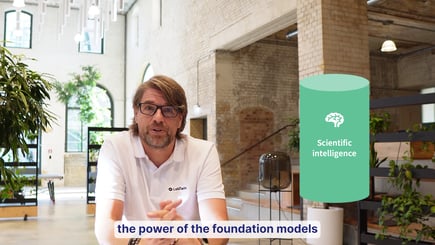
LabTwin represents more than just a product; it's a visionary approach aimed at revolutionizing laboratory operations through intelligent solutions. We firmly believe that the future of scientific innovation lies in the powerful combination of human intuition and real-time AI computational capabilities right at the laboratory bench.
Jeroen de Haas, Head of Product at LabTwin shares about the impact of AI in the field and how this will shape the LabTwin product:
Impact of the AI Revolution in the Lab
Recent breakthroughs in AI technology are predicted to reshape laboratory operations dramatically. Large Language Models (LLMs) possess exceptional capabilities in supporting scientists. They can assist in various tasks, such as retrieving specific information, summarizing findings, and automating daily tasks. With AI's support, scientists can enhance their efficiency, allowing them to concentrate on experiments and realize faster experiment cycles by leveraging insights in real-time.
AI has now become remarkably user-friendly, enabling interactions through natural language as we could all witness with ChatGPT. This accessibility therefore extends to individuals without any programming skills, making AI more approachable to a broader audience. Coupled with a voice recognition interface, the power of AI can be extended not only to a non-tech audience but also to individuals who are unable to access a computer during their activities, such as lab scientists.
The next 5-10 years hold the promise of an AI-driven digital transformation within laboratories. AI's potential lies in unlocking historical data insights, discovering correlations, predicting outcomes, and reducing the number of experiments required. Scientists can shift their focus from data curation to making more groundbreaking discoveries. Furthermore, AI has the potential to provide scientists with personal assistants, a level of support previously reserved for high-level executives.
Empowering Scientists with Smart Personal Assistants
Our journey of over five years in this field and ongoing client interactions have unveiled a common need: the capability to interact with lab data more intelligently. Our objective is to offer an educated personal assistant available 24/7 for seamless data capture of observations and results during laboratory work, but also a 'lab mate' designed to access the wealth of knowledge held by laboratory professionals, compiling their insights within LabTwin and making them accessible to the entire research group.
LabTwin's integration of AI aligns with the need to provide scientists with the most technologically advanced and user-friendly assistant possible. AI is a fundamental pillar of LabTwin's mission, and our team of accomplished data scientists is dedicated to integrating highly specialized models into our product to cater to scientists' needs.
Smart Data Capture and Structuring
Data capture during complex and often time-sensitive experiments at the bench has historically been a significant challenge for scientists. Often, data collection is minimalistic and disorganized, requiring time-consuming curation and recalling of missing insights.
Through enhanced Machine Learning, we have revolutionized data capture at the bench by allowing hands-free data entry through natural language. And now, AI's deep understanding of captured content, including entity detection, can enable automatic data structuring, saving time and minimizing errors.
The development of a robust, context-aware voice-enabled interface for laboratory processes presents ongoing challenges, but recent AI developments have definitively accelerated our efforts to simultaneously provide scientists with a natural interface for data capture and analysts with standardized outputs.
Optimizing Experimental Design and Execution
Prior to entering the lab, scientists spend time designing or revising their protocols. If a new experiment requires a new protocol, it doesn't necessarily have to be created from scratch; scientists typically rely on past experiences and recent results to adapt existing protocols.
One of the great strengths of LLMs is the capability of integrating a vast amount of knowledge and using it to address new demands. We anticipate that AI will play a pivotal role in optimizing experimental design by leveraging previous protocols, introducing new steps, and implementing data validation rules. Augmenting LabTwin with these capabilities will lead to quicker protocol design with the flexibility to modify steps or quantities based on real-time results.
In the execution phase, access to the company's knowledge or general scientific information is often essential to ensure safety guidelines are followed or to troubleshoot unexpected issues. However, this access is often limited to the notes displayed in the lab or the partial knowledge of colleagues present. Otherwise, it necessitates interruptions to search in the appropriate database or lab informatics system. LLMs, as demonstrated by ChatGPT, are proficient at parsing multiple sources of data and retrieving essential information, considerably speeding up the searching time. As LabTwin aims to become the round-the-clock virtual companion for scientists, integrating with LLMs and providing an interface for hands-free scientific or company-specific information retrieval is a natural evolution of our product.
Automation and Augmentation
The drive to capture high volumes of standardized data has led many labs to explore automated solutions. This has sparked discussions about whether scientists may be replaced by machines in the lab and rather focus on experiment design and method development. Now, as AI continues to advance, there is growing concern about the potential replacement of human contributions for more intellectual talks.
LabTwin firmly believes in human-AI collaboration. Humans possess unique creative thinking abilities and intuition, making them indispensable in innovative processes. Humans will always be better at thinking outside the box, following some gut-feeling (or even mistakes!) that lead to the next discovery. AI's role is to enhance, not replace, human scientists, making work more efficient and freeing scientists to focus on creativity and accelerate experiment cycles.
Security and Ethical Considerations
The manipulation of data using cloud-based LLMs often raises critical questions regarding data security and compliance. LabTwin places a strong emphasis on data integrity and security through encryption and rigorous data segmentation, ensuring the protection of sensitive data. Compliance with organizational and regulatory rules is a top priority, as evidenced by our achievement of certificates for ISO 27001 and 27017 compliance.
LabTwin is also committed to transparency, always aiming to deliver the most accurate answers from AI processes. It shares data sources, allowing scientists to verify AI outcomes. AI remains a supportive partner in the lab, and the responsibility for validating AI contributions rests with scientists.
Starting the Future Now
AI has been increasingly integrated into scientific research to enhance target identification or accelerate operations. With the LLMs breakthrough, it is now being made available for individual use cases. By embedding the latest AI advancements into our digital lab assistant, we are pioneering the field of smart assistance for bench scientists. We are discovering new use cases every day, contributing to the advancement of AI in the lab. In parallel, our pursuit of technical and commercial partnerships with other players in the field is vital, as integration within the lab informatics landscape is essential for our product and will unlock new AI use cases to surface insights or automate requests. We are excited to roll out these exciting AI features to our clients starting from November 2023.
Reach out to our digitalization experts to discuss your own use cases and digitalization goals, or simply book a demo in our calendar.

%20(1)-1.png?width=164&height=164&name=Ellipse%2052%20(Stroke)%20(1)-1.png)